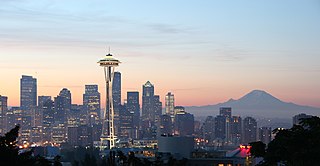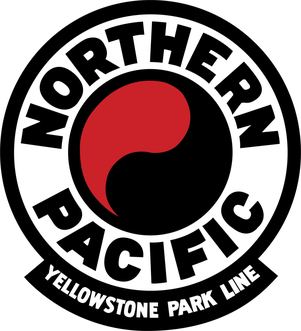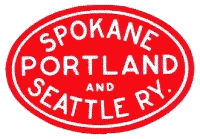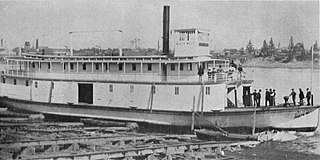
The Pacific Northwest, sometimes referred to as Cascadia, is a geographic region in Western North America bounded by its coastal waters of the Pacific Ocean to the west and, loosely, by the Rocky Mountains to the east. Though no official boundary exists, the most common conception includes the U.S. states of Oregon, Washington, Idaho, and the Canadian province of British Columbia. Some broader conceptions reach north into Alaska and Yukon, south into northern California, and east into western Montana. Other conceptions may be limited to the coastal areas west of the Cascade and Coast mountains.

Cowlitz County is a county located in the U.S. state of Washington. As of the 2020 census, its population was 110,730. The county seat is Kelso, and its largest city is Longview. The county was formed in April 1854. Its name derives from the anglicized version of the Cowlitz Indian term Cow-e-liske, meaning either 'river of shifting sands' or 'capturing the medicine spirit.' Cowlitz comprises the Longview, WA Metropolitan statistical area, which is also included in the Portland-Vancouver-Salem, OR-WA Combined statistical area.

Midland is a census-designated place (CDP) in Pierce County, Washington. The population was 9,962 at the time of the 2020 census.

The Great Northern Railway was an American Class I railroad. Running from Saint Paul, Minnesota, to Seattle, Washington, it was the creation of 19th-century railroad entrepreneur James J. Hill and was developed from the Saint Paul & Pacific Railroad. The Great Northern's route was the northernmost transcontinental railroad route in the U.S.

The Seattle and Walla Walla Railroad was a 3 ft narrow gauge railroad and was the first proper railroad to serve Seattle, Washington, preceded only by horse-drawn rail vehicles and by a coal train making the very short haul from Lake Union to Pike Street. Despite its ambitious name, actual construction never went beyond King County, the county of which Seattle itself is the seat. After being sold to Henry Villard's Oregon Improvement Company in 1880 it was renamed the Columbia and Puget Sound Railroad. In 1916, that became the Pacific Coast Railroad Company.

The Northern Pacific Railway was an important transcontinental railroad that operated across the northern tier of the western United States, from Minnesota to the Pacific Northwest. It was approved and chartered in 1864 by the 38th Congress of the United States in the national / federal capital of Washington, D.C., during the last years of the American Civil War (1861-1865), and given nearly 40 million acres of adjacent land grants, which it used to raise additional money in Europe, for construction funding.

Goble is an unincorporated community in Columbia County, Oregon, United States. It is located on U.S. Route 30 and the Columbia River.

The Spokane, Portland & Seattle Railway was a railroad in the northwest United States. Incorporated in 1905, it was a joint venture by the Great Northern Railway and the Northern Pacific Railway to build a railroad along the north bank of the Columbia River. The railroad later built or acquired other routes in Oregon. The SP&S was merged into the Burlington Northern in March, 1970. Remnants of the line are currently operated by BNSF Railway and the Portland and Western Railroad.

The North Coast Limited was a named passenger train operated by the Northern Pacific Railway between Chicago and Seattle via Bismarck, North Dakota. It started on April 29, 1900, and continued as a Burlington Northern Railroad train after the merger on March 2, 1970 with Great Northern Railway and the Chicago, Burlington and Quincy Railroad. The next year, it ceased operations after the trains which left their originating stations on April 30, 1971, the day before Amtrak began service, arrived at their destinations.

Spokane, Portland & Seattle 700 is the oldest and only surviving example of the class "E-1" 4-8-4 "Northern" type steam locomotive and the only surviving "original" Spokane, Portland and Seattle Railway steam locomotive. It was built by the Baldwin Locomotive Works in May 1938. Nearly identical to the class "A-3" Northerns built for Northern Pacific Railway, it burns oil instead of coal.
Historic ferries in Oregon are water transport ferries that operated in Oregon Country, Oregon Territory, and the state of Oregon, United States. These ferries allowed people to cross bodies of water, mainly rivers such as the Willamette in the Willamette Valley, and the Columbia, in order to transport goods, move people, and further communications until permanent bridges were built to allow faster crossing of the water. The early ferries were used by wagons and pedestrians, while later ones transported trains and then automobiles. Oregon has a few automobile ferries still in operation.

Burlington Northern Railroad Bridge 9.6 or BNSF Railway Bridge 9.6, also known as the Columbia River Railroad Bridge, is through truss railway bridge across the Columbia River, between Portland, Oregon, and Vancouver, Washington, owned and operated by BNSF Railway. Built by the Spokane, Portland and Seattle Railway (SP&S) and completed in 1908, it was the first bridge of any kind to be built across the lower Columbia River, preceding the first road bridge, the nearby Interstate Bridge, by a little more than eight years.

The Port of Longview is a deep-water port authority located in Longview, on the Columbia River in southwest Washington, United States. It was established in 1921 by Washington state law, and operates as a unit of local government. The port is overseen by a locally elected, three-member board of commissioners. Each commissioner is elected for a six-year term and is directly responsible to the voters for port operations.

The Pacific Northwest Corridor or the Pacific Northwest Rail Corridor is one of eleven federally designated higher-speed rail corridors in the United States and Canada. The 466-mile (750 km) corridor extends from Eugene, Oregon, to Vancouver, British Columbia, via Portland, Oregon and Seattle, Washington, in the Pacific Northwest region. It was designated a high-speed rail corridor on October 20, 1992, as the one of five high-speed corridors in the Intermodal Surface Transportation Efficiency Act of 1991 (ISTEA).
Longview is an unincorporated historic community in Benton County, Washington, United States, located approximately three miles west of Umatilla, Oregon on the north bank of the Columbia River, just above Devil's Bend Rapids.

Emma Hayward commonly called the Hayward, was a steamboat that served in the Pacific Northwest. This vessel was once one of the finest and fastest steamboats on the Columbia River and Puget Sound. As newer vessels came into service, Emma Hayward was relegated to secondary roles, and, by 1891, was converted into a Columbia river tow boat.

Wenat was a stern-wheel steamboat that, under the name Swan, was built and operated, briefly, on the Tualatin River, in the state of Oregon. In 1858, Swan was sold, moved to the lower Willamette River, renamed Cowlitz, and placed on a route between Portland, Oregon the Cowlitz River.

Northwest was a steamboat that operated on the Columbia, Cowlitz and lower Willamette rivers from 1889 to 1907. In 1907 Northwest was transferred to Alaska, where it sank on the Skeena River

Joseph Kellogg was a stern-wheel driven steamboat that operated on the Willamette, Columbia, and Cowlitz rivers for the Kellogg Transportation Company. It was named after the company's founder, Joseph Kellogg (1812-1903). The sternwheeler Joseph Kellogg was built in 1881 at Portland, Oregon.






















